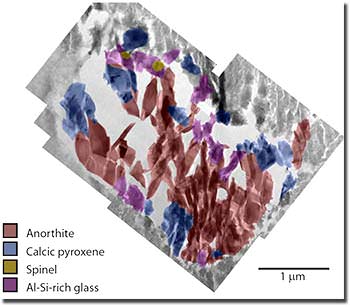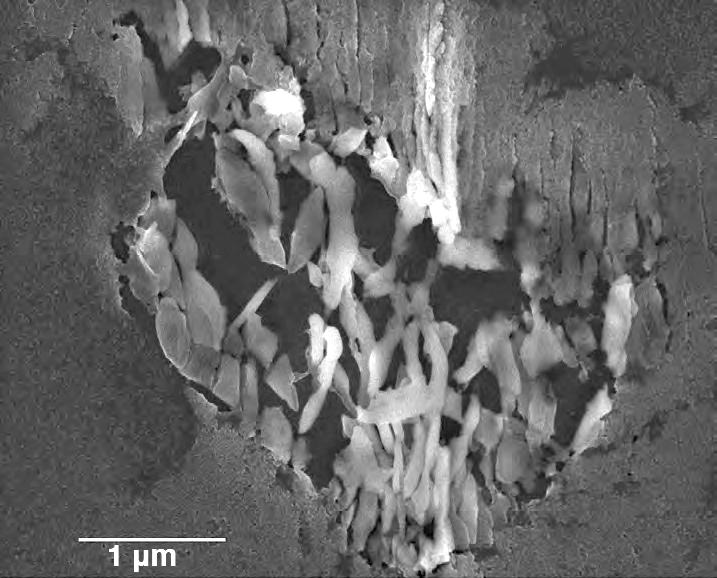[/caption]
One of the most surprising results from the Stardust mission – which returned comet dust samples to Earth in 2006 – is that comets don’t just consist of particles from the icy parts of the outer solar system, which was the common assumption, but also includes sooty dust from the hot, inner region close to the Sun. A new study confirms this finding, and also provides the first chronological information from the Wild 2 comet (pronounced like Vilt 2). The find paints a chaotic picture of the early solar system.
Even some of the first looks at the cometary particles returned by Stardust showed that contrary to the popular scientific notion, there was enough mixing in the early solar system to transport material from the sun’s sizzling neighborhood and deposit it in icy deep-space comets. Whether the mixing occurred as a gentle eddy in a stream or more like an artillery blast is still unknown.
“Many people imagined that comets formed in total isolation from the rest of the solar system. We have shown that’s not true,” said Donald Brownlee back in 2006, principal investigator for Stardust.
The new study, conducted by scientists from Lawrence Livermore (Calif.) National Laboratory, shows the dust from comet 81P/Wild 2 has been altered by heating and other processes, which could have only occurred if a transport of space dust took place after the solar system formed some 4.57 billion years ago.
“The mission was expected to provide a unique window into the early solar system,” the team, led by Jennifer Matzel wrote in their paper, “by returning a mix of solar system condensates, amorphous grains from the interstellar medium, and true stardust – crystalline grains originating in distant stars. Initial results, however, indicate that comet Wild 2 instead contains an abundance of high-temperature silicate and oxide minerals analogous to minerals in carbonaceous chondrites.”

They analyzed a particle from the comet, about five micrometers across, known as Coki. The particle does not appear to contain any of the radiogenic isotope aluminum-26, which implies that this particle crystallized 1.7 million years after the formation of the oldest solar system solids. This means that material from the inner solar system must have traveled to the outer solar system, across a period of at least two million years.
“The inner solar system material in Wild 2 underscores the importance of radial transport of material over large distances in the early solar nebula,” said Matzel. “These findings also raise key questions regarding the timescale of the formation of comets and the relationship between Wild 2 and other primitive solar nebula objects.”
The presence of CAIs in comet Wild 2 indicates that the formation of the solar system included mixing over radial distances much greater than anyone expected.
Sources: LLNL, Astrobiology


I love science. Especially when it confirms what I’ve always thought!
“…but also includes sooty dust from the hot, inner region close to the Sun.”
Does ‘sooty’ mean carbon filled?
Any shocked nano diamonds in there?
I too feel rewarded when science tests my conception of reality.
In this case I have started to suspect that, as in biology, transient processes are unnecessarily argued as sudden due to lack of (mainly) temporal resolution. This test my prediction that such man made preconceptions will fall if tested.
Just the other day I gleaned another such area. A few weeks ago there was this paper that rather conclusively (in this layman’s eyes) tested that the dominant part of our volatiles must have come from such cometary material we see above, presumably at the Last Heavy Bombardment (LHB) at 4.1 to 3.8 Ga. Isotope ratios couldn’t explain the magmatic content solely by way of planetoid collision and subsequent differentiation.
“This “heavy” Kr cannot generate modern atmosphere through degassing followed by mass fractionation during atmosphere loss. We are therefore led to the conclusion that neither early outgassing nor impact-driven degassing of the early mantle represented by these gases are responsible for generating the noble gases in the present-day atmosphere. […] Earth’s modern atmosphere is then a mixture of a relatively late fractionated solar gas and an even later cometary source.”
Yet I have now understood that the early Earth indeed have a reasonable supply of volatiles, accounting for the isotope ratios of our earliest rocks. Already 2001 people knew that early zircons from 4.4 Ga, i.e. just 150 My after Earth coalesced but 300 My before the LHB, had contact with a decent liquid supply.
“The correlation of high δ18O values and enriched LREEs is most consistent with the melting of continental crust or sediments, but whichever of these processes dominated, a large reservoir of liquid water is required on the surface of the Earth.”
This constrains pro- and protobiotic theories. We can see ambiguous but yet consistent evidence for life, such as stromatolites or carbon isotope ratios consistent with resulting from metabolism, up to the earliest tectonic plate material that occurred right after the LHB at 3.8 Ga.
There is even similar indications from diamond inclusions from similar zircons as above from 4.2 – 4.3 Ga, IIRC. And modern impact models says that cells easily survive our own and other systems eventual LHB’s by their multiplying and mobility outstripping impactors ability to sterilize volumes of planetary crust.
Summing it all up there is reason to believe that life started as soon as there were enough volatiles, sometime before or after 4.4 Ga, but likely before the supply rate dropped off at 3.8 Ga. This means that probiotic theories like thermo-osmosis (tested by todays chemo-osmotic cell machinery) have a leg up on theories like Zn world (tested by todays still ubiquitous use of Zn, traceable back to the earliest ribozymes and protein folds) that needs something like 10 at of CO2 before ZnS photosynthesis starts.
Presumably the lipid et cetera material that clad the first cellular like inorganic open vent vacuoles of materials such as ZnS (less likely the organic destructive FeS) originated from Fischer-Tropsch like processes instead of Zn world photosynthesis of CO2 to formic acid. That would be enough to get thermo-osmotic pathways started on their way to self-reproducing metabolism.
Then again, the absence of a preferred chemosynthesis pathway that formic acid photosynthesis impress, means that the old “chicken-and-egg” paradox of “what came first, enzymes or metabolism” that it promise to resolve remains.
Yet taking the earliest life traces of 4.3 Ga for real means that life started at the latest 100 – 200 My after the first volatiles were present in liquids. It is then indeed another representative of the more gradual processes rather than the abrupt ones earlier envisioned. It didn’t have to wait for much volatiles at all.
And somehow it, presumably then again gradually instead of decisively so, resolved the above metabolic paradox in ways that we are yet to find out. Curious.
Nancy, some people might not know what a CAI is unless they read the release from LLNL.
It strikes me that one way that would keep the Zn world hypothesis intact is if indeed early volatile supply included at least 10 atmospheres of CO2, while the end result were way above that and something similar to Venus.
There is of course no reason to think not, and every reason to think that Venus and Earth were alike each other, before plate tectonics stopped/never started on Venus for whatever reason.
I think I like that. Then the above comment remains in main, and specifically the observation of the gradual processes of getting atmospheres respectively life. It is but the gradualness of the “enzymes or metabolism” paradox resolution that fails miserably – Zn world did it inherently at the outset.